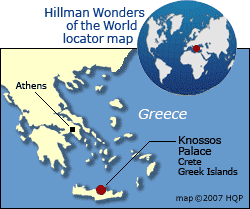Knossos Palace
 Why
Knossos Palace
on the Greek Island
of Crete is special
Why
Knossos Palace
on the Greek Island
of Crete is specialThe Knossos Palace gives us an insight on the ancient Minoan Civilization, which was a Bronze Age trading power. It had a vast mercantile fleet with far-flung trade routes that reached more than a thousand miles from Greece.
Knossos Palace tips and insights
Function
Knossos Palace was likely the governmental, cultural and religious seat of the Minoan Civilization of Greece, which began around 2,000 BC.
Throne Room is the top attraction
Knossos Palace likely had over 1,300 rooms. Among those that have been restored, the Throne Room is the tourist favorite.
How to pronounce
Knossos: nohs'-us
Greek Mythology
The mystique of Knossos Palace is enriched by ancient Greek mythology accounts, including:
-
Icarus
He fell into the sea and drowned when trying to escape the palace because he flew too close to the hot sun. His artificial wings dropped off when the wax securing them melted.
- The Minotaur
This half-man, half-bull monster lived and was slain in the stronghold's labyrinth.
Several theories explain why the Minoan Civilization perished around 1450 BC after having thrived for centuries. The most popular theory:
-
Volcanic eruption
Just 115 kilometers (70 miles) away, a volcano erupted on the Greek Island of Thera (called Santorini in modern Greece). The powerful explosion created a massive tsunami and thick ash clouds.
-
Theory
The tsunami and ash clouds destroyed most of the Minoan mercantile fleet and settlements. To make matters worse, when the ash clouds reached the farmlands of some distant Minoan trading partners, their economies and therefore their ability to trade with the Minoans was severely hamstrung.
Knowledge of the the Minoan existence slowly disappeared from the recorded history of Greece.
Discovery
The Knossos Palace was discovered in 1878 by a man named Kalokairinos. He only superficially excavated it.
Controversial excavation
In 1900 the Englishman and amateur archaeologist Sir Arthur Evans took over and did a comprehensive excavation job. His restoration is basically what we see today. Critics say he used too much imagination in determining the palace's former appearance.
Tourist perspective
Although archaeologists have reason to deplore Evans' guesstimations, I understand why most travelers to Greece would approve of his work. They would rather view a somewhat fanciful recreation than a field of tumbled building blocks that only an archaeologist could love.
"Minoan Civilization" name
Arthur Evans coined the term "Minoan Civilization" after the legendary gold-rich King Minos of Crete. We do not know what the society called itself.
Location in Greece



